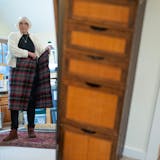Minnesota fishing guide Jason Mitchell remembers when overnights on the ice in a portable shelter were more about survival than fun.
Condensation would fall from the poorly insulated ceiling. D batteries powering the shelter's air-circulation fan would fail in the middle of the night. Lighting was dim, elbow room was nonexistent and certain propane heaters were worrisome.
"You ended up being miserable," he said.
At last weekend's St. Paul Ice Fishing and Winter Sports Show, Mitchell was celebrating a new era. Upsized shelters, advances in thermal insulation, built-in LED lighting, affordable and long-lasting lithium-ion batteries, carbon monoxide detectors, cots that can be stacked like bunk beds and rubber mat flooring have saved ice camping.
"More and more people are using these hubs to camp," Mitchell said. "You set up a folding table with a cooking stove, bring a jug of water. … The equipment is so much more trustworthy than it used to be."
A member of the Clam Outdoors pro fishing staff, Mitchell spent part of the show's opening day at a luxurious display of a six-sided, pop-up, hub shelter that featured ample room for two anglers to spend at least a few days on the ice.
The industry keeps developing accessories like rattle reels and cell phone holders that screw into the circular, interior hubs where the tents' structural poles connect to one another. Adding to those conveniences, compact lithium-ion batteries can be purchased with enough capacity to run fish-finding electronics, fans and lighting for days.
Mitchell said part of the ice camping trend is for groups of fishing friends to set up "villages" on the ice, sharing resources and building camaraderie. Portable carbon monoxide detectors are a must, he said, and a Minnesota-based technology company has expanded into the ice-fishing scene with camping-friendly Heat Hog portable heaters.


